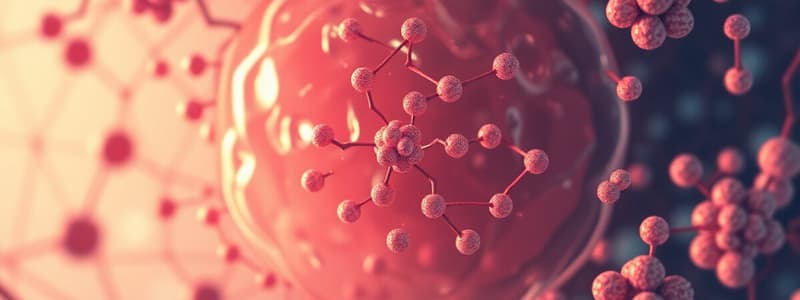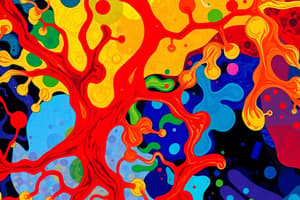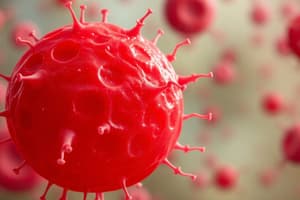Podcast
Questions and Answers
Which of the following statements accurately describes the function of protein channels in the cell membrane?
Which of the following statements accurately describes the function of protein channels in the cell membrane?
- They exclusively transport lipids across the cell membrane.
- They allow water and small water-soluble molecules to pass through the membrane. (correct)
- They prevent any movement of ions across the cell membrane.
- They facilitate the passage of all molecules regardless of size or solubility.
What is the primary difference between 'doorless' ion channels and 'gated' ion channels?
What is the primary difference between 'doorless' ion channels and 'gated' ion channels?
- Doorless channels require ATP to function, while gated channels do not.
- Doorless channels are always open, while gated channels open and close temporarily. (correct)
- Doorless channels are impermeable to ions, while gated channels are always open.
- Doorless channels can only transport water, while gated channels transport ions.
Which type of gated channel opens in response to a change in the electrical potential across the cell membrane?
Which type of gated channel opens in response to a change in the electrical potential across the cell membrane?
- Always open channel
- Voltage-gated channel (correct)
- Ligand-gated channel
- Mechanically-gated channel
Which of the following best describes the function of tight junctions?
Which of the following best describes the function of tight junctions?
What is the fundamental difference between passive and active transport mechanisms across the cell membrane?
What is the fundamental difference between passive and active transport mechanisms across the cell membrane?
In the context of cell biology, what does the term 'osmosis' specifically refer to?
In the context of cell biology, what does the term 'osmosis' specifically refer to?
A cell is placed in a solution, and water moves into the cell, causing it to swell. Which of the following best describes the solution?
A cell is placed in a solution, and water moves into the cell, causing it to swell. Which of the following best describes the solution?
What is the primary distinction between primary and secondary active transport?
What is the primary distinction between primary and secondary active transport?
Which process describes the movement of large molecules from inside the cell to the extracellular environment through fusion of vesicles with the cell membrane?
Which process describes the movement of large molecules from inside the cell to the extracellular environment through fusion of vesicles with the cell membrane?
The sodium-potassium pump is crucial for maintaining cell volume. What accurately describes its function?
The sodium-potassium pump is crucial for maintaining cell volume. What accurately describes its function?
Which of the chemical messengers listed travels through the bloodstream to reach target cells throughout the body?
Which of the chemical messengers listed travels through the bloodstream to reach target cells throughout the body?
What is a key characteristic of paracrine signaling?
What is a key characteristic of paracrine signaling?
How do autocrine signals primarily function?
How do autocrine signals primarily function?
Where are neurotransmitters released to act on a target cell?
Where are neurotransmitters released to act on a target cell?
Which of the following is a function of cytokines?
Which of the following is a function of cytokines?
What role do receptors play in cell signaling?
What role do receptors play in cell signaling?
Which of the following is an example of a cell membrane receptor?
Which of the following is an example of a cell membrane receptor?
What event typically initiates the activation of a G-protein dependent receptor?
What event typically initiates the activation of a G-protein dependent receptor?
What is the role of GTP in G-protein signaling?
What is the role of GTP in G-protein signaling?
In the context of signal transduction, what are 'second messengers'?
In the context of signal transduction, what are 'second messengers'?
Which of the following is a typical function regulated by activation of the cAMP system?
Which of the following is a typical function regulated by activation of the cAMP system?
What is the role of adenylyl cyclase in the cAMP pathway?
What is the role of adenylyl cyclase in the cAMP pathway?
How does cAMP exert its effects within the cell?
How does cAMP exert its effects within the cell?
What is the effect of cAMP-dependent protein kinase?
What is the effect of cAMP-dependent protein kinase?
In the Calcium signaling pathway, what is the direct effect of the signal molecule, once phospholipase C is activated?
In the Calcium signaling pathway, what is the direct effect of the signal molecule, once phospholipase C is activated?
What intracellular effect does inositol trisphosphate (IP3) have in the calcium signaling pathway?
What intracellular effect does inositol trisphosphate (IP3) have in the calcium signaling pathway?
How does calcium exert its effects as a second messenger?
How does calcium exert its effects as a second messenger?
What is a primary function of protein phosphorylation in signal transduction?
What is a primary function of protein phosphorylation in signal transduction?
Where in the cell are intracellular receptors typically located?
Where in the cell are intracellular receptors typically located?
What is the typical mechanism of action for hormones that bind to intracellular receptors?
What is the typical mechanism of action for hormones that bind to intracellular receptors?
How is the signal from a receptor tyrosine kinase (RTK) typically transmitted into the cell?
How is the signal from a receptor tyrosine kinase (RTK) typically transmitted into the cell?
Which event is characteristic of a ligand-gated ion channel receptor?
Which event is characteristic of a ligand-gated ion channel receptor?
In cell signaling, what is the effect of a mutation that prevents a receptor from being internalized (endocytosed)?
In cell signaling, what is the effect of a mutation that prevents a receptor from being internalized (endocytosed)?
Several signaling pathways can overlap, involving cAMP and Calcium. Which result is true about their overlap?
Several signaling pathways can overlap, involving cAMP and Calcium. Which result is true about their overlap?
Referring to the G-protein system of working, what does the active enzyme trigger?
Referring to the G-protein system of working, what does the active enzyme trigger?
How does the selective permeability of the cell membrane influence the movement of molecules?
How does the selective permeability of the cell membrane influence the movement of molecules?
What role do aquaporins play in facilitating transport across the cell membrane?
What role do aquaporins play in facilitating transport across the cell membrane?
How does the presence of gates in protein channels affect ion transport?
How does the presence of gates in protein channels affect ion transport?
What characteristic is common to both tight junctions and desmosomes?
What characteristic is common to both tight junctions and desmosomes?
What distinguishes diffusion from osmosis as passive transport mechanisms?
What distinguishes diffusion from osmosis as passive transport mechanisms?
What accounts for the osmotic effect that is seen in cells?
What accounts for the osmotic effect that is seen in cells?
How do uniport, symport, and antiport carriers differ in their function during active transport?
How do uniport, symport, and antiport carriers differ in their function during active transport?
How does the sodium-potassium pump counteract the effects of osmosis to maintain cell volume?
How does the sodium-potassium pump counteract the effects of osmosis to maintain cell volume?
What role does the extracellular fluid (ECF) play in both paracrine and autocrine signaling?
What role does the extracellular fluid (ECF) play in both paracrine and autocrine signaling?
How do neurotransmitters facilitate communication between neurons at a synapse?
How do neurotransmitters facilitate communication between neurons at a synapse?
What is the immediate consequence of a first messenger binding to a receptor on the cell membrane?
What is the immediate consequence of a first messenger binding to a receptor on the cell membrane?
How does a G-protein couple receptor activation to its downstream effects?
How does a G-protein couple receptor activation to its downstream effects?
How does cAMP-dependent protein kinase mediate cellular responses in the cAMP pathway?
How does cAMP-dependent protein kinase mediate cellular responses in the cAMP pathway?
What best describes the process initiated when a signal molecule activates phospholipase C in the calcium signaling pathway?
What best describes the process initiated when a signal molecule activates phospholipase C in the calcium signaling pathway?
How is signal transmission achieved via protein phosphorylation?
How is signal transmission achieved via protein phosphorylation?
Flashcards
Protein Channels
Protein Channels
Water and water-soluble molecules pass through these in the cell membrane.
Doorless Channels
Doorless Channels
Channels that are continuously accessible.
Gated Channels
Gated Channels
Channels that open and close temporarily.
Voltage Gate
Voltage Gate
Signup and view all the flashcards
Ligand Gated
Ligand Gated
Signup and view all the flashcards
Gap Junction
Gap Junction
Signup and view all the flashcards
Tight Junction
Tight Junction
Signup and view all the flashcards
Passive Transport
Passive Transport
Signup and view all the flashcards
Active Transport
Active Transport
Signup and view all the flashcards
Diffusion
Diffusion
Signup and view all the flashcards
Osmosis
Osmosis
Signup and view all the flashcards
Isotonic
Isotonic
Signup and view all the flashcards
Hypertonic
Hypertonic
Signup and view all the flashcards
Hypotonic
Hypotonic
Signup and view all the flashcards
Active Transport
Active Transport
Signup and view all the flashcards
Primary Active Transport
Primary Active Transport
Signup and view all the flashcards
Secondary Active Transport
Secondary Active Transport
Signup and view all the flashcards
Endocytosis
Endocytosis
Signup and view all the flashcards
Exocytosis
Exocytosis
Signup and view all the flashcards
Sodium-Potassium Pump
Sodium-Potassium Pump
Signup and view all the flashcards
Chemical Messengers
Chemical Messengers
Signup and view all the flashcards
Paracrines
Paracrines
Signup and view all the flashcards
Autocrines
Autocrines
Signup and view all the flashcards
Neurotransmitters
Neurotransmitters
Signup and view all the flashcards
Hormones
Hormones
Signup and view all the flashcards
Cytokines
Cytokines
Signup and view all the flashcards
Protein receptors
Protein receptors
Signup and view all the flashcards
First Messenger
First Messenger
Signup and view all the flashcards
G-Protein Dependent Receptor
G-Protein Dependent Receptor
Signup and view all the flashcards
Second Messenger
Second Messenger
Signup and view all the flashcards
Tyrosine-Kinase Receptors
Tyrosine-Kinase Receptors
Signup and view all the flashcards
Ion Channel Receptors
Ion Channel Receptors
Signup and view all the flashcards
Intracellular Receptors
Intracellular Receptors
Signup and view all the flashcards
Adenylyl Cyclase
Adenylyl Cyclase
Signup and view all the flashcards
Cyclic AMP Pathway
Cyclic AMP Pathway
Signup and view all the flashcards
Protein Phosphorylation
Protein Phosphorylation
Signup and view all the flashcards
Diacylglycerol (DAG) & inositol triphosphate (IP₃)
Diacylglycerol (DAG) & inositol triphosphate (IP₃)
Signup and view all the flashcards
Study Notes
- The following notes cover cell membrane transition, communication, and second messengers.
Cell Membrane Composition
- The cell membrane consists of a phospholipid bilayer, with polar heads facing outward into watery environments and nonpolar tails forming the interior.
- Glycoproteins and glycolipids are present on the cell surface and are important for cell recognition.
- Proteins, both peripheral and integral, are embedded in the membrane, facilitating various functions.
- Cholesterol is present within the membrane, contributing to its fluidity and stability.
Membrane Proteins Functions
- Transport: Proteins facilitate the movement of specific molecules or ions across the membrane.
- Intercellular Joining: Membrane proteins connect cells together.
- Enzymatic Activity: Some membrane proteins act as enzymes, catalyzing reactions at the membrane surface.
- Cell-Cell Recognition: Proteins identify cells.
- Signal Transduction: Receptor proteins bind to signaling molecules and initiate a cellular response.
- Attachment: Proteins attach to the cytoskeleton and extracellular matrix, maintaining cell shape and stability.
Protein Channels
- Protein channels allow water and water-soluble molecules to pass through the cell membrane.
- Water channels are also known as aquaporins.
- Non-lipid-soluble molecules, such as water, can pass through protein channels if small enough.
- Ion channels allow ions like Na, K, Cl, and Ca to rapidly pass through the plasma membrane.
- Protein channels feature gates that control the permeability of the channel.
Ion Channels
- Some ion channels are always open (doorless), while others are temporarily opened and closed (gated).
- Membrane permeability to ions can rapidly change due to the opening and closing of gated channels.
- Voltage-gated channels are sensitive to voltage changes.
- Ligand-gated channels are sensitive to chemical changes.
Membrane Connections
- Gap junctions: These are for cell communication.
- Tight junctions: Create a tight seal.
- Desmosomes: Provide strong adhesion between cells.
Transport Across the Cell Membrane
- Passive transport: Molecules move down their concentration gradient, without cellular energy, e.g., diffusion and osmosis.
- Active transport: Requires cellular energy to move molecules against their concentration gradient, e.g., active transport, endocytosis, exocytosis, and phagocytosis.
Diffusion
- Diffusion is the movement of ions or molecules from an area of high concentration to an area of low concentration.
- Molecules and ions are in constant motion in body fluids.
Osmosis
- Osmosis occurs with water passing through a selectively permeable membrane from a less dense to a denser environment.
Tonicity Concepts
- Isotonic: The extracellular and intracellular environments have equal osmotic activity
- Hypertonic: Solutions with a higher solute concentration cause cells to shrink
- Hypotonic: Solutions with a lower solute concentration cause cells to swell
Active Transport Types
- Uniport: Transports a single molecule
- Symport: Transports two different molecules in the same direction
- Antiport: Transports two different molecules in opposite directions
- Primary active transport: Uses ATP directly.
- Secondary active transport: Uses ATP indirectly.
Endocytosis and Exocytosis
- Endocytosis: Transports substances from outside the cell to inside
- Exocytosis: Transports substances from inside the cell to outside
- These processes transport large molecules (proteins, polysaccharides, and polynucleotides).
Sodium-Potassium Pump
- Hydrolyzing an ATP molecule enables 3 Na ions to be moved out and 2 K ions to be moved into the cell.
- Sodium-potassium pump action is necessary for maintaining the cell volume.
- Without the pump, cells would swell and burst, the osmotic effect from water would not be in balance.
Chemical Messengers
- Cells communicate through intercellular chemical messengers.
- The six types of chemical messengers include paracrines, autocrines, neurotransmitters, neurohormones, hormones, and cytokines.
- Chemical messengers act on target cells when released into the extracellular fluid (ECF) upon appropriate stimulation.
- Chemical messengers differ in source and how they reach target cells.
Paracrines
- Paracrines target cells in the immediate environment of their release site.
- Paracrines operate via diffusion.
- Paracrines inactivated by local enzymes.
Autocrines
- Autocrines bind to receptors on the very cell that secreted them, regulating their own secretion.
Cytokines
- Cytokines are secreted, then diffuse to neighboring target cells.
- Cytokines are secreted and transported by blood to distant target cells.
- Interleukins and interferons are examples.
Neurotransmitters
- Neurotransmitters secreted from neurons at synapses.
- Neurotransmitters released from the axon terminal of a presynaptic cell that binds to receptors on a postsynaptic cell.
- Neurotransmitters act locally on a neuron, muscle, or a gland.
Hormones
- Hormones are secreted by endocrine cells into the interstitial fluid and enter the bloodstream.
- Hormones target cells with matching receptors.
- Cells lacking receptors are unresponsive to the hormone's signals.
Signal-Target Interaction
- There are basic cell membrane receptors:
- G-Protein dependent receptors
- Tyrosine-kinase receptors
- Ion channel receptors
First Messengers
- First messengers bind with specialized protein receptors on the plasma membrane.
- Hormones and neurotransmitters act as first messenger.
- Messenger + receptor triggers events like secretion and metabolism.
G-Protein Dependent Receptors
- They work with the help of a receptor known as the G-protein.
- The G-Protein is loosely attached to the cytoplasmic side of the membrane.
Binding of Extracellular Chemical Messenger
- Opening closing of specific ion channels
- Transfering the signal to an intracellular chemical messenger (second)
Second Messengers
- The binding of an extracellular chemical messenger brings about a desired cellular response.
- This happens by opening/closing specific channels or transfering the signal to an intracellular messenger.
G-protein-coupled receptors
- A neurotransmitter binds to a receptor resulting in effector protein.
- Then G-protein is activated.
- G-protein modulates ion channels.
Tyrosine-Kinase Receptors
- Monomers become a dimer structure.
- Activating transfer protein.
Ion Channel Receptors
- A ligand, a signalling molecule, binds its specific site on the membrane.
- A change in the shape of the channel proteins occurs, which causes concentration of an ion to modify.
- Stimulates electrical impulses
Intracellular Receptors
- Hydrophobic molecules pass from the membrane and bind their receptors inside the cell.
- Steroid and thyroid hormones, and NO are examples.
Protein Phosphorylation
- Protein phosphorylation is the basic signal transmission mechanism.
Activation of 2nd Messenger Systems
- Extracellular chemical messengers cannot enter cells. Instead, messengers bind to membrane, activation intracellular proteins.
Cyclic AMP Pathway
- Extracellular messenger + receptor activates adenylyl cyclase.
- G-protein acts as an intermediary.
- G proteins are bound to guanine nucleotides, guanosine triphosphate (GTP) or guanosine diphosphate (GDP).
- G proteins are on the inner surface of the plasma membrane.
Cyclic AMP Pathway Action
- The effector protein is the enzyme adenylyl cyclase.
- Adenylyl cyclase converts intracellular ATP to cAMP
- cAMP activates a cAMP-dependent protein kinase, which phosphorylates, and changes the shape of intracellular proteins
- Cyclic AMP activates a specific enzyme.
Calcium as a Second Messenger
- A first messenge binds to surface receptor G proteins and then activates phospholipase C.
- Next is phosphatidylinositol biphosphate or PIP₂.
- The last is diacylglycerol (DAG) and inositol triphosphate (IP₃).
Cyclic AMP and Calcium Pathways
- Pathways frequently overlap in bringing about a particular cellular activity.
- cAMP and Calcium can influence each other.
- Calcium activated calmodulin regulates adenylyl cyclase and cAMP.
- Cyclic AMP-dependent kinase phosphorylate and change the activity of Calcium channels or carriers.
Studying That Suits You
Use AI to generate personalized quizzes and flashcards to suit your learning preferences.




